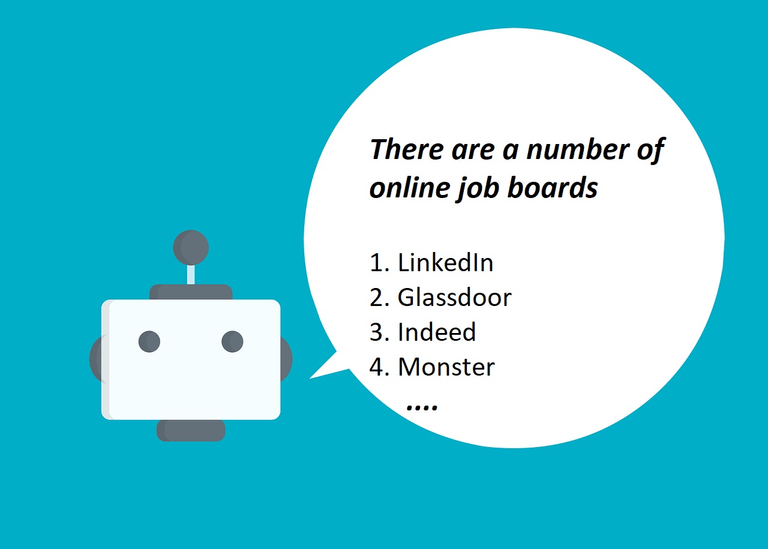Why do you want to do SEO if you are a recruitment company with a job board?
Search engines and, more precisely, Google are one of the key sources of traffic for recruitment companies that have job boards in Europe. As a result, any change in Google impacts recruitment companies.
Generative AI (GenAI) is the technology shaping chatbots such as GTPchat. What’s game-changing is that Google and Bing integrated this technology into their search engines. As a result, the answers are generated thanks to Generative AI technology. You can learn more about it by taking a basic introduction created by Google.
Google speaks about Search Generative Experience. Let’s see an example of Search Generative Experience taken from the Google blog post “Supercharging Search with generative AI” (see image 0: Search Generative Experience)
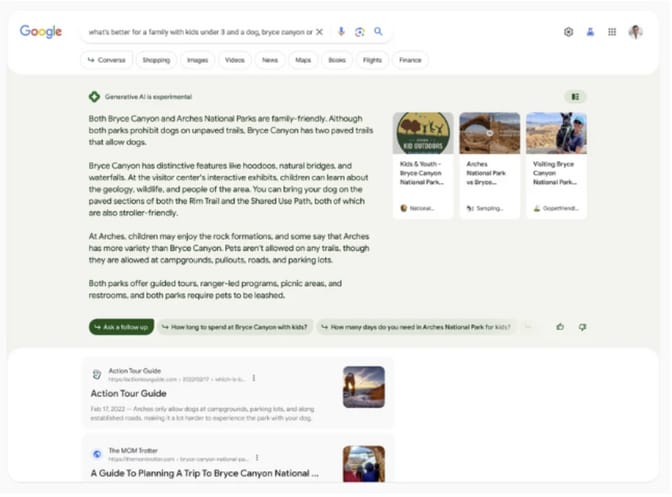
See image 0: Search Generative Experience
Now, let’s see an exemple of GenAI answer given by Bing for the question “how can I improve my CV for the German market” (see image 1: CV for the German market)

See image 1: CV for the German market
I get a very different experience than I was getting some months ago on Bing. Back then I would have had some ads, traditional blue links, and probably some other things like People Also Ask. However, I would surely not have had an answer as the chatbot one.
What you see on Bing and Google will soon be available also in Europe on Google. However, you still have time to adapt and build a solid strategy to ensure that your brand is part of those quoted by the answer engine.
What I have noticed by working with recruitment companies
What I have noticed by working with recruitment companies that have a job board is that:
- Recruitment companies have mandates for a specific profile which are difficult to find & need to find qualitative candidates.
- Recruitment companies with a job board also offer positions for jobs in which there is competition with other organisations (even with the organisations that hired the recruitment company).
- Recruitment companies with a job board often offer supplementary services such as CV review, career path analysis, etc.
- The domain is very competitive.
Job Boards are under increasing pressure to find ways of attracting more candidates to their sites. This blog post will explain how to adapt to the new search engines and chatbots to ultimately increase your site's visibility and conversions.
How Chatbot impacts potential candidates' Search
Before diving deeper into the SEO strategy, it is important to explain that there are two ways to access GenAI answers in Google and Bing. Do notice that you might not have access to these features yet depending on the region you live in.
- Directly go on a chatbot like Bingbot or Google's chatbot (Bard) and ask a question
The first example is the Google Chatbot (Bard). You can click on Converse, and you will have a more conversational answer.

The second example is Bing Chatbot (Bingchatbot). You can click on chat, and you will have access to their chatbot.

It’s still difficult to say for sure how candidates will use the chatbot or how search engines will integrate it into their answers. However, from the information we got from Bing and by using a bit of logic, chats are for conversations (See image 2: Type of intent/Pubcon Fabrice Canel). As a result, they will probably be used for everything supporting the core business but not for the core business of a recruitment company with a board. For instance, if I want to know more about a position, want to know how to improve my CV, or have a list of interview questions and much more.
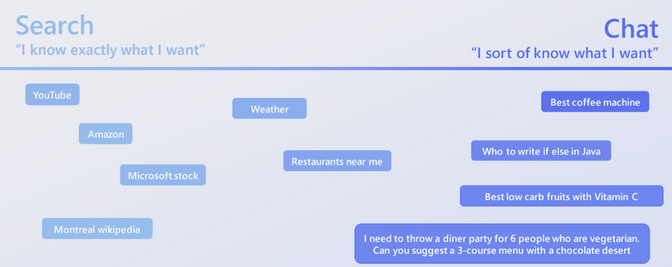
See image 2: Type of intent/Pubcon Fabrice Canel
I don’t exclude that somebody could ask a question such as “digital marketing jobs in Switzerland”. However, despite my multiple tentatives, I was always getting a list of job boards or recruitment companies. The same happens on BARD(See image 3: BARD). Never a proper list of jobs contrary to the search engines where you get an answer at first glance (See image 4: List of jobs at first glance).
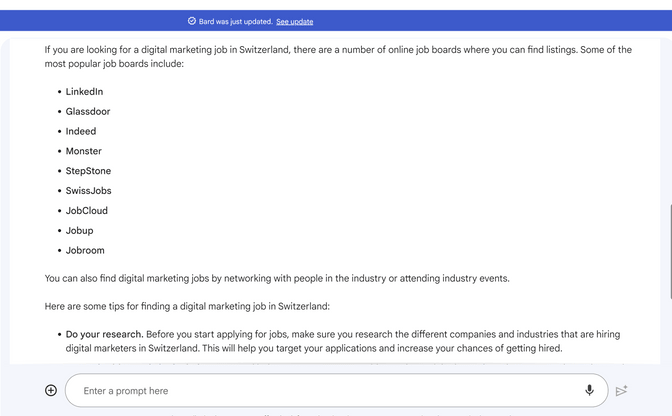
See image 3: BARD
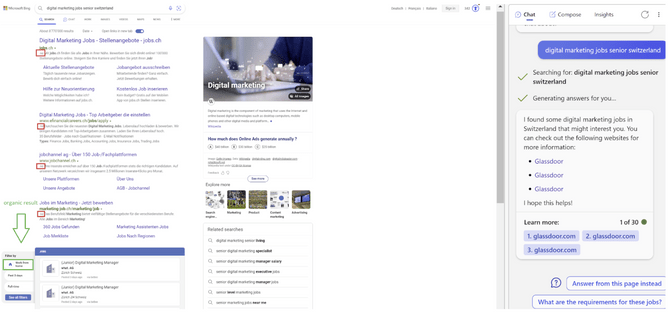
See image 4: List of jobs at first glance
- Go to Google or Bing search engine, ask a question in the search bar and get an answer like the one got in the chatbot as it’s shown in the image below (mobile version).
In this case, the search engine and the answer engines became just one thing. This also happens in the new Google search engine. It just has a different interface, but the logic is very similar (in both cases generative AI plays a role).
How chatbots could impact recruitment companies that have a job board
- As you can see with the query: “digital marketing jobs in Switzerland”, only one answer is shown. From the many tests done, it’s possible to say that we get between one to three/four links (sometimes more but rare) related to a brand. What’s disturbing is that depending on the device, you will have more in the quotes +(x) implies that not all the quotes are visible. Even worse, If you are not in one of those suggested links, you are not visible. For instance, in the image we have seen, there are 3 references to Glassdoor. As a result, I will not have people coming from the chatbot to my website.
- Some companies are well-known for some specific jobs, for e.g Cinfo is well-known for recruiting Swiss people for UN jobs. This is a significant advantage because their brand will be part of whatever I’m on search or answer engines (See image 5: Cinfo_BingChatBot).
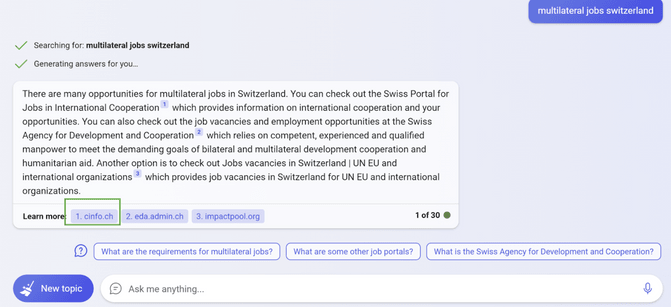
See image 5: Cinfo_BingChatBot
What’s the SEO strategy for recruitment companies that have a job board?
Preliminary work
Before deciding what to do, it’s important to do preliminary work and understand where you stand:
- Is the brand an entity
This asks for some background on what an entity is.
Entities are people, places or things. A machine will translate it into a number. We could simplify the concept by saying an entity is a name with a number assigned that the machine can read. As an example, we take Stepstone, which is a German job board. The machine (Google or Bing) will connect the name Stepstone with an ID, which will be used to find the information about the company. The knowledge graph ID (machine readable number) for Stepstone is /m/0lq9yhv (See image 6: Stepstone)

See Image 6: Stepstone
- What the engine understands about your brand
The first thing is to see if Google/Bing understands your core business. To see what Google understands about your brand, you can get the information through the Google knowledge graph tool (this is a paid tool that asks for a bit of development knowledge).
Alternatively, you can check the knowledge panel (if you have one) and see the description (See image 7: Stepstone Knowledge panel). In the Stepstone case, there is a knowledge panel but no description. This could indicate that Stepstone is not giving a consistent description of the company or they don’t have a description on their website that clarifies who they are. For instance, if we check the about us page, we don’t have a description on their website, and get redirected to another website. You can read more about the description of the entity here.
It’s always possible to use the search engines/answer engines and ask “What does Stepstone do” This could indicate Google and Bing's understanding of what the company does.

See image 7: Stepstone Knowledge Panel
- What are the connections between your brand and the other entities?
If you are an entity, surely, your entity is related to other entities. The goal is to understand what you are related to and if the relationship makes sense. A trick to find related entities is to use Google images (See image 8: filters in Google images). Each time you select those images, you get new relationships; this helps create a graph of the relationships.

See image 8: filters in Google images
Creating the SEO strategy for Answer engines
I personally think that a very good approach is to use the Kalicube approach, which was created by Jason Barnard. The Kalicube process is based on three steps:
- Understanding
- Credibility
- Deliverability
I recently had the opportunity to work with Jason on the deliverability part of this process and how this can be adapted to the answer engines.
-
Understand your solution. This means that you need to be an entity, and who you are and what you do needs to be understood. All our preliminary work was to figure out where we stand. This will determine the fundamental work we need to do. For instance, if we look at Stepstone, we know that they have a machine-readable ID (remember:(link: https://www.google.com/search?kgmid=/m/0lq9yhv text: /m/0lq9yhv target: _blank)), but from the knowledge panel, we also know that they are improvements to do. It’s essential to notice that you can be in the answer engine (chatbot) without being an entity. However, this also means that the machine is “guessing”. When the machine guesses, there are chances that there are some errors in the answers or in the follow-up questions. You can learn more about how the system works by reading LaMDA: Language Models for Dialog Applications
-
Being perceived it as more credible than the competition
In the Kalicube process, credibility is another wording for the more complex concept of EEAT. That means that if you create content, you need to demonstrate Experience, Expertise, Authoritativeness and Trustworthiness in the subject of the content piece.
Some simple ways of being perceived as more credible by search engines are by including data about the number of jobs filled and client testimonials. However, those things need to be proven. Here is where the external sources come in handy. In the Kalicube process, this is called corroborating the sources. For example, if you have testimonials saying that they were hired to work for company X thanks to your website in position Y, you want this to be reflected on LinkedIn. This is a very small example, but it gives the logic of having sources that confirm your story.
The interesting part is that all this generates a virtuous circle because by working on convincing the Engines of your credibility both onsite and offsite, you will also convince your audience from top to bottom of your acquisition funnel. This brings us to the last part, the delivery part.
- The content you create needs to be Deliverable.
Deliverability aims to provide an excellent customer experience for each touchpoint of the buyer’s decision journey. This is primarily about producing targeted content in the correct format and secondly about the technical side of the website (speed, H and other technical requirements). An excellent starting point is to use the Pedowitz Group's Customer Journey model and produce content for each step. Often the second part of the customer’s decision journey (after somebody buys your product) is forgotten. In the case of a recruitment company with a job board, it could be that after somebody applies for the job, the platform does not follow up with the person. The moment that a candidate applies, it is just the first step of the process. They probably need help to prepare for the interview, or if they get rejected, they look for support. Preparing the material also for people that already bought your product, in this case, applied on your website (or subscribed to your talent pool) has two advantages:
- If people go to an answer engine for support about “how to prepare for an interview for company X for position Y” there are chances that the brand with the ready answer will be part of the answer engine references.
- If the answer engines recognise your entity and your credibility, there is a big chance that the suggested questions relate to your buyer’s decision journey. As a result, that will push the user all along your buyer’s decision journey through the suggested questions.
Let’s take as an example “digital marketing jobs in Switzerland”, LinkedIn was one of the references in Bing chatbot, now if I select the suggested question “What are the top companies hiring for digital marketing jobs in Switzerland” the magic happens. I have a list and a final sentence saying you can learn more about these companies on LinkedIn (See image 9: suggested questions). So that means that you can check each of those companies on LinkedIn. If you go to Acodis

See Image 9: suggested questions
I can directly go to LinkedIn and check for Acodis (see image 10: GenAI push down the funnel), and this is what I get:

See image 10: GenAI push down the funnel
Conclusion
In conclusion, this is an exciting and scary time for recruitment companies that have a job board. On the one hand, being in the answer engines (chatbot) is an opportunity. On the other hand, it requires (most probably) rethinking the SEO strategy. This will result in the capacity to attract quality candidates. Don’t hesitate to contact us if you want to work on your new SEO strategy.

